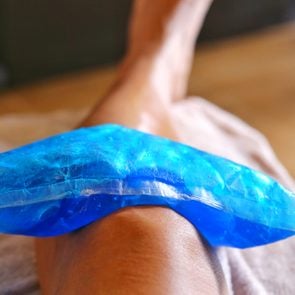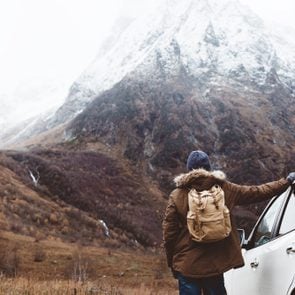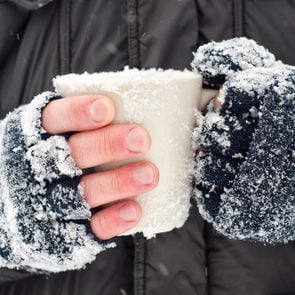This Man Broke 15 Bones When He Fell into a Glacier—Here’s How He Survived
Updated: Aug. 15, 2022
He knew that if he couldn't climb out, that crack in the ice would become his grave.
Our editors and experts handpick every product we feature. We may earn a commission from your purchases.
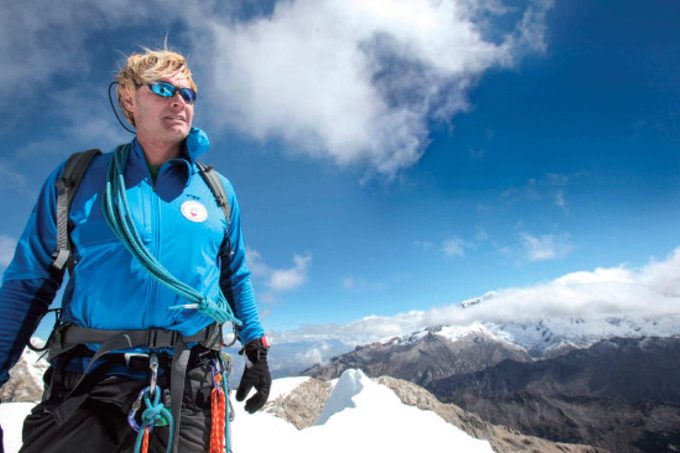
John All unzipped his tent, poked his shaggy blond head out into the thin alpine air, and took in the view. The sun sparkled off the freshly fallen snow on the jagged peaks and crags of Mount Himlung. It was just before 10 a.m. on May 19, 2014—a perfect morning in the Himalayas.
All, a 44-year-old scientist, had come to Nepal on a research expedition to collect snow samples for his study of pollution. His two climbing partners had retreated down to base camp until one of them could recover from a stomach ailment. They were expected back in a day or two, but for now, All was alone at 20,000 feet. Climbing solo in the Himalayas is never advisable, but All’s plan was to remain cautious, stick near camp, and begin collecting samples. But first, he was dying for a cup of coffee.
He grabbed his snow axes and walked toward a flat area a short distance away that looked like an ideal spot to gather fresh snow to melt for water. The temperature was between 25 and 30 degrees. After weeks at high elevation, that felt positively balmy, so All was dressed lightly in wind pants, a thin jacket over a T-shirt, and hiking boots with crampons—metal spikes that help climbers traverse icy terrain. He took a step and then another. Suddenly the ground gave way beneath him, and he plunged into darkness.
All’s face smashed into something hard as he plummeted downward. He instinctively reached out with his right hand, trying to jab an ax into the ice to slow his progress, but the weight of his falling body wrenched his arm out of its shoulder socket, leaving behind a mess of shattered bone and torn soft tissue. As he careened against the icy walls with growing speed, his mind seemed to slow down. He realized with horror what had happened: He had stepped into a crevasse, a crack that had opened in the glacier and extended down who knew how deep.
How did I make this mistake? he thought. Then he had another thought: There’s no way you can survive a crevasse fall.
All’s right side slammed into something hard, his fall stopping with a crunch of bones. I’m dead, he thought. Then he felt his lungs heaving, straining to suck wind back into his body, each gasp bringing a jolt of excruciating pain. He looked down and saw his legs hanging over a chasm. He had landed on a shelf of ice suspended above the blackness. Overhead was a pale halo of blue-white light, seven stories up, where he had punched through the crust of snow. The entire right side of his body had been crushed. He couldn’t move. But for now, he was alive.
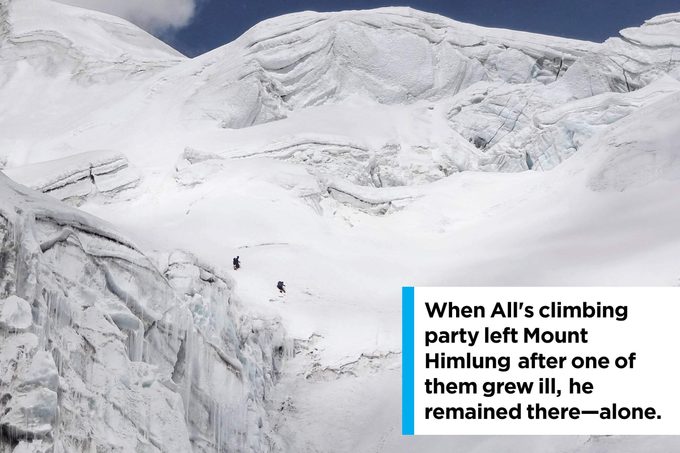
How he got there
John All was not supposed to be on Mount Himlung. A month earlier, he had been at Mount Everest Base Camp sharing black tea with a young Sherpa. Asman Tamang, a shy father of a 9-month-old, was climbing Everest for the first time, and All teased him, saying Tamang would make record speed up the mountain. All had climbed Everest before, but this time he was leading an expedition of scientists to Everest’s sister peak, Mount Lhotse, to collect evidence of “black dust,” emissions from factories thousands of miles away. For All, a professor at Western Kentucky University, the mountains were a second home—the rare place where the six-foot-five former triathlete could combine his love of physical adventure with his scientific curiosity.
On the morning of April 18, All woke to the ground rumbling. An ice shelf had collapsed, sending a chunk of ice the size of an apartment building tumbling down the side of Everest. Sixteen climbers were killed, Asman Tamang among them.
Everest and Lhotse were shut down for the season. After a week of mourning his friend, All and his two partners headed to nearby Mount Himlung to continue their work.
From his icy seat 70 feet deep in the earth, John All gasped for breath and tried to gather his thoughts. Climbers fall into crevasses all the time, but those who survive usually fall only a short way, aren’t by themselves, and certainly aren’t badly injured. All knew of only one person who had made it through such a long fall and climbed out by himself: the mountaineer Joe Simpson, who had survived a fall in Peru. All would try to become the second.
 Six hours to make it to the surface
Six hours to make it to the surface
Taking in his surroundings, All realized he wasn’t on a shelf but a chunk of ice that had fallen through the fissure and become wedged between the walls. In an ever-moving, ever-shifting glacier, how long would it stay wedged? He rocked his body slightly, testing his limitations, and a jolt of pain radiated through him, leaving him dizzy. He had 15 broken bones in total, he would learn later, including six crushed vertebrae. His right arm was entirely useless, and the ribs on his right side were shattered, making every breath agony. His abdomen felt sore and stiff, a sign of internal bleeding, and he had a coppery taste in his mouth, an indication of possible kidney or liver damage. He touched his face and found that blood from gouges in his eye socket and forehead had congealed in the cold, stopping the bleeding momentarily. (Here are more weird ways your body reacts to freezing temperatures.)
It took All almost 10 minutes just to wrench himself upright and squirm over to a secure perch on his block of ice. The effort left him panting. Icy air blew up from the depths of the glacier. Already he could feel his body shivering and his fingers freezing, quickly becoming numb. By 4 p.m., the shadows cast by the high mountain peaks would leave him in the dark and unable to climb. His research partners weren’t scheduled to come back to camp until the next day or possibly even the day after. By then, he would have frozen to death. He had roughly six hours to make it to the surface and to his tent, or he would die.
All is a researcher, someone who makes a record of everything he does. Now, out of instinct, he reached into his pocket, brought out his camera, and pressed record. “Thank God I stopped on this ledge,” he said to the camera, his breath ragged, spatters of blood visible in the snow. “How do I get back up there, though?” Above him, the snow was soft; the air from the crevasse condensed on the walls and left a surface the consistency of whipped cream. Where he had landed, the width of the crevasse was about eight feet, but looking to his right, he saw a spot hundreds of feet away where the fissure appeared to narrow. If he was lucky, it just might be narrow enough for him to “chimney” his way up, or climb by bracing his body against both sides of the crevasse until he reached the surface, all while using only one arm. First, though, he would need to get there, using his crampons and snow axes to move across the wall of sheer ice.
All kicked the points of his crampons into the ice until they held. With his left hand, he planted one ax at eye level, then he reached the same hand across his body to plant the other ax as far to the right as possible.
Clutching the first ax, he shuffled his feet to the right, kicked his crampons into the ice, shifted his weight, and then grabbed the second ax, again with his left hand. His body screamed with pain, but he had moved. Now he just had to do this a few thousand more times.
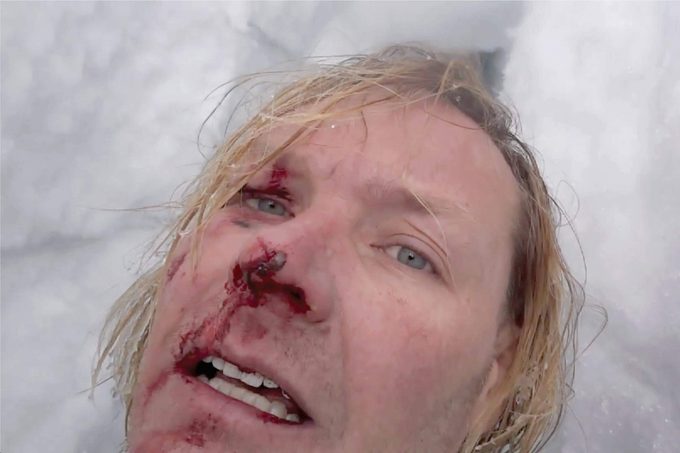
Functioning well in dangerous situations
Stab with the ax, kick his feet, shift his weight, repeat. All was free-climbing inside a crack in the mountain, trying not to dwell on the fact that one misstep would send him tumbling to his death. Instead he concentrated on getting to another slab of ice that had become lodged in the crevasse about 50 feet up. Over the years, All had found that he functioned well in dangerous situations. He had a tattoo of a black mamba on his calf—a token of the time he had kicked a six-foot-long poisonous snake in Botswana before it could strike. He tried to make the climb an academic puzzle, a question of geometry. If he could figure it out, he would live.
Stab, kick, shift, repeat. At times the ice gave way beneath All’s crampons, sending chunks of the wall tumbling into the chasm, but his ax held him tight.
After about half an hour, he had reached the slab of ice. He rested, gratefully gulping the meat-locker–cold air into his lungs. The sound of his own jagged breath as he struggled to get enough oxygen at this altitude mixed with the cracking of the glacier, that living, moving mass of ice that surrounded him. He knew that if he didn’t make his way out, his body would likely remain there for years. Perhaps when the glacier had retreated, future generations would discover the corpse in the green windbreaker and wonder who had been foolish enough to go climbing alone.
He started moving again, his eyes fixed on the next ice block, about 50 feet to his right. Suddenly, a jolt of inexpressible pain struck. He looked down and saw the void beneath him, the cavern disappearing into a black infinity. Against his will, the thought flashed through his mind: I’m going to die. He thought of his 67-year-old mother and imagined her sadness on receiving the news. Then he gathered himself again and forced himself on, stabbing the ax back into the wall.
Now the edges of the crevasse were narrowing, the surface of the walls a tangle of icy protrusions and deceptively fragile crystalline formations that All scraped aside with his frozen fingers. Slowly he began to climb upward, swinging his ice tools into the walls and finding his footing, each step taking excruciating minutes as he tried to gather his energy. The crevasse was tight enough for him to chimney his way up now, and he braced his back against the wall. Stab, kick, shift, repeat. Time moved strangely in the crevasse—marked by uneven breaths—but he was making progress. After about four hours in the crevasse, All could see the glow of the sun beneath a thin crust of snow.
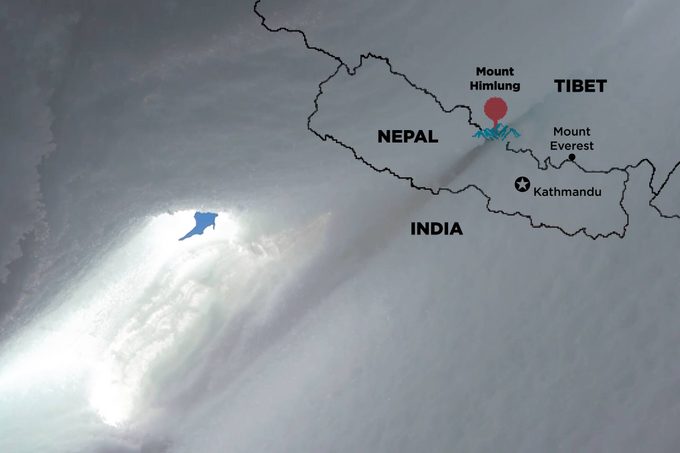
Back on solid ground
Finally he swung an ax upward and broke through. A tiny patch of blue sky appeared. As All cleared the snow, making the hole wider, he had the distinct feeling that he had just dug himself out of his own grave. He hauled himself up and lay there, halfway in and halfway out, utterly exhausted and unable to move. Five minutes later, with a final burst of energy, he forced his body to flop forward onto solid ground. He staggered to his feet and immediately collapsed again. He couldn’t walk. He could barely get to his knees. That’s when he realized just how truly broken his body was and how much trouble he was still in.
In the Himalayas, death from hypothermia comes quickly. All was a three-minute walk away from his tent, but it might as well have been three miles. You didn’t come this far to not make it, he told himself. He pulled his body forward on his stomach. His face plowed through the snow. All shivered in agony as he dragged his broken ribs across the ground.
The short walk took two hours of crawling. It was late afternoon and the shadows were deepening when he finally lunged into the tent. All reached for his handheld satellite communicator. He knew he wouldn’t survive until his partners reached him. He was bleeding internally and needed to be rescued. The walkie-talkie–sized machine could only send messages, not make phone calls, and at the moment, it was connected to the Facebook page of an organization he’d cofounded, the American Climber Science Program. Back home in Kentucky, it was 4 a.m. Everyone he knew was likely asleep, but he prayed someone would see his cry for help. With numb fingers he typed out a message: “Please call Global Rescue. John broken arm, ribs, internal bleeding. Fell 70 ft crevasse. Climbed out. Himlung camp 2,” he posted. “Please hurry.”

Arranging rescue from around the world
From her house on the Big Island of Hawaii, biologist Rebecca Cole was getting ready for bed when she decided to log on to Facebook. When she saw John All’s message, her heart sank.
Cole and her husband, Carl Schmitt, had cofounded the American Climber Science Program with All. He was the guy they referred to as their “charismatic megafauna”—a big, fun presence with a magnetic personality who drew people to the organization. When Cole read her friend’s cry for help, she quickly began pinging messages across the globe, trying to arrange a helicopter rescue.
On Mount Himlung, All was spending the longest night of his life. His throat was parched, but with only one working arm, he couldn’t manage to open his water bottle. He sucked down two energy gels, tried to cover his body with his sleeping bag, and lay in a dazed pain in the dark.
Finally the light outside began to change, the sun creeping up the edges of the tent and warming his chilled body. On the other side of the world, his friends were trying to find a rescue team willing to take a helicopter to such an altitude, where the air is thin and aircraft can act erratically.
After 18 hours on his back—his broken body had tensed up, leaving him near paralysis—All heard the faint whir of a helicopter. Soon after, the tent’s door unzipped and a Nepali rescuer poked his head through the flap. The rescuer dragged All on his sleeping mat before hauling him into the helicopter.
As the copter twisted through the Himalayas, All finally allowed the relief to flood through him. “I’m alive,” he whispered.

The start of his true recovery
As All recovered from his injuries, he sometimes felt as if a part of him had never escaped the crevasse. He talked freely about Tamang’s death and his own escape, but he kept himself the teller of the story, not the subject. “It was all so raw and overwhelming,” says All. “I had to keep it in the third person.”
In March 2015, almost a year after his near-death experience, All visited Rebecca Cole in Hawaii. By now he was physically healed, but Cole could see that her friend was still shaken. So, she says, “I took a week off to take John on as many hikes and adventures as he was physically able to handle.” One day, they climbed Mauna Loa, the largest volcano in the world. As they trekked, it began to snow—a rarity in tropical Hawaii—and soon they were breaking trail through three feet of snow on their way to the summit. Being in the snowy mountains for the first time since his accident and discovering that the experience still made him feel happy and at peace marked the beginning of All’s true recovery.
All is now a research professor at Western Washington University. He is also fulfilling a lifelong desire to train the next generation of climber scientists at the Mountain Environments Research Institute, which he founded in 2016. “We all have dreams, but we usually say, ‘I’ll do it when I get a chance,’” says All. “Lying on that mountain, I realized you get only one chance to live.”
Read John All’s book: Icefall: Adventures at the Wild Edges of Our Dangerous, Changing Planet.














